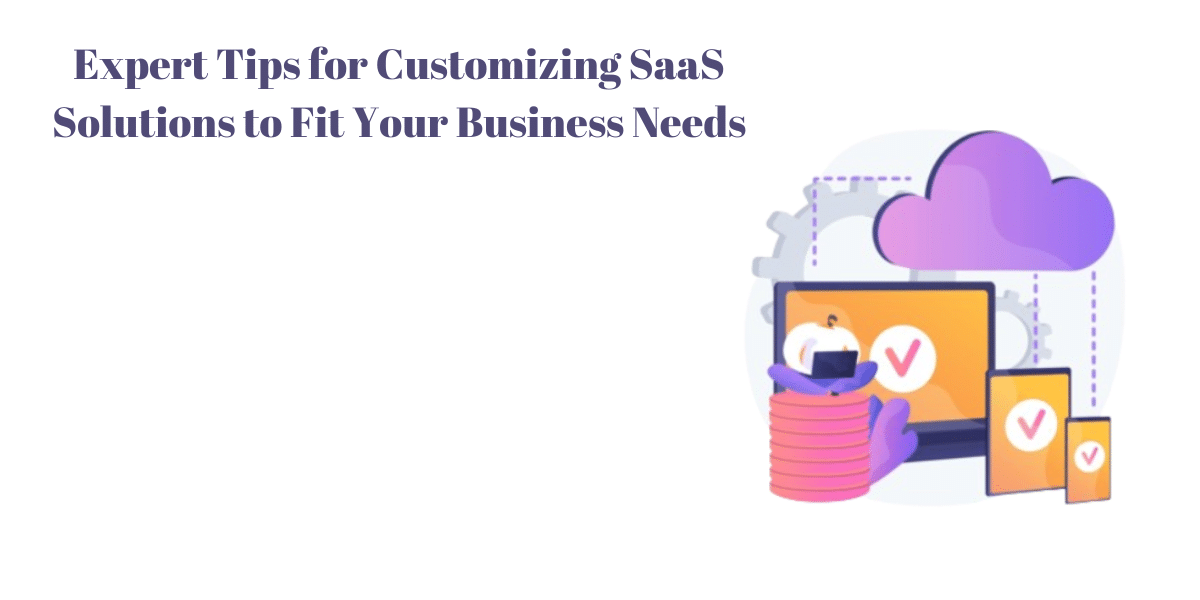In the constantly evolving world of technology for business, the strategy-driven adoption and customization of SaaS solutions has become necessary for companies seeking custom and effective digital solutions. As more businesses realize the need for agility scaling, customized functions, and the need for flexible SaaS solutions has increased.
This extensive guide covers important aspects like understanding the business needs and integrating with the existing infrastructure, ensuring data security, and increasing user acceptance. With the help of the experts in this document, companies can begin an adventure to modify their SaaS software solutions and ensure their business is secure in an ever-changing and crowded digital environment.
Evaluating SaaS Solution Features
Evaluation of SaaS solutions’ features is essential in setting up digital tools to meet specific business requirements. A thorough assessment of the features makes sure that the selected SaaS solution is not just able to meet the current needs but also allows for future growth. Begin by conducting an in-depth study of the fundamental functions offered to users by this SaaS platform, focusing on elements like storage of data processing capabilities, storage capacity, and integration options.
Analyze how these capabilities align with the company’s operational workflows, focusing on effectiveness and user-friendliness. Consider options for customization that allow you to tailor the solution to the company’s specific requirements while ensuring that it is a seamless integration into the existing workflows. Scalability is an important consideration when choosing a SaaS solution. It provides the ability to expand with the company, allowing for increased users and data volumes.
Also, consider the product’s compatibility with new technology and trends in the industry keeping up-to-date with developments ensures that you are investing in a long-term solution. Check out the roadmap of the vendor for enhancements and feature updates to ensure continuous effectiveness and support. Additionally, consider the system’s flexibility to various business models, since this increases its flexibility across various departments and roles. A thorough analysis of SaaS capabilities is the basis for successful modification, which allows enterprises to maximize their digital infrastructure for long-term expansion and competitiveness in a constantly changing technological environment.
Customization Considerations for Industry Specifics
The process of customizing SaaS Solutions require a sophisticated approach, especially when it comes to addressing specific industry needs. Since businesses operate in a variety of industries, the considerations for customization need to be tailored to meet the specific needs and requirements of every sector. Begin by conducting an in-depth review of specific industry workflows as well as compliance requirements and operational complexities.
Consider that customization goes beyond the surface, and requires a knowledge of the ways in which the SaaS solution will seamlessly integrate and improve existing processes. Focus on features that specifically cater to the issues and opportunities that are prevalent in the field making sure that the modification does not just meet current requirements but also anticipates the future. Collaboration with experts in the field and other stakeholders is essential to gain insight into subtleties that might not be evident from a technical perspective by itself.
Think about the flexibility that this SaaS solution to support specific terminology and reporting standards for the industry and formats for data. Security and compliance with data are crucial, and your customization should conform to specific regulations for the industry to protect confidential information. Furthermore, the ability to grow and adapt to changing trends in the industry is crucial to maintain the longevity of the custom solution. The key is that considerations for customization to specific industry needs an understanding of all the particular challenges and requirements within a particular sector making sure that the custom SaaS solution is an enabler for excellence in operations and competitive advantages in the specific industry.
Scalability Planning for Future Growth
Scalability planning is a crucial element when designing Software as a Service (SaaS) solutions to anticipate and adapt to the future growth. Businesses must adopt a forward-looking approach that is beyond the immediate requirements and consider the potential increase in the volume of data as well as user base and operational complexity. Begin by looking into the features that allow for scalability of the selected SaaS solution, and evaluating the ability of it to handle more workloads, without impacting performance.
Evaluate the software’s capability to be integrated with other modules functions, functionalities, or other third-party software that could be needed as the company expands. Stress that it is important to have flexible licensing models that are aligned with the changing requirements of users. In addition, scalability planning involves anticipating the changes in business processes, making sure that the custom SaaS solution is able to adjust to the changing workflows and requirements. Partner tightly with your SaaS provider to learn about their plans for future updates and enhancements to ensure that the solution is scalable and current with regard to technological advances.
Think about the impact that expanding geographically over the SaaS infrastructure, and address any localization requirements or compliance requirements that might be required. Planning for scalability is not just about technical aspects, but is it is also about aligning the custom solution to the overall vision and strategy of the business. Through meticulously planning for scalability, companies can secure and secure their SaaS investments, increasing flexibility and resilience while they navigate through the constantly changing world of innovation and growth.
User-Centric Interface Design
Designing for user-centric interfaces is a key element in the personalization and personalization of SaaS solutions which influence the overall experience for users and ensuring the widespread acceptance. An effective interface is geared towards the preferences, requirements and workflows of the end-users which results in increased efficiency and satisfaction. Begin by conducting thorough study to determine the different demands and skills of the targeted group of users. Utilize intuitive navigational designs, which minimize the amount of complexity and maximizing the functionality of your application to increase efficiency for users.
Make sure to prioritize the principles of responsive design, which ensures access across a variety of sizes of screens and devices. Create a user interface that is adapted to the particular roles and tasks of the various users within the company. Use uniform design elements, including the use of color schemes and typography to make a visually appealing user interface. Testing with users is vital to refine the design, and incorporating feedback from users to address pain issues and improve the overall user experience. Think about your options for personalization, which allow users to alter their interface in accordance with their personal preference and preferences.
Collaboration between developers, designers as well as end-users is crucial to creating a user-centric design that creates a greater understanding of the needs of users and facilitates continual improvement. In the end, a user-centric design does more than enhance the user experience, but also helps in the successful adoption and use of the customized SaaS solution, bringing technology in line with the human element that is at the center of the organization’s activities.
Integrating with existing IT Infrastructure
A seamless integration with your an existing IT infrastructure is a crucial aspect when modifying SaaS solutions, as it ensures seamless coexistence between both new and existing systems. Start by conducting an extensive analysis of your present IT environment, looking for potential integration points, and assessing the compatibility with the selected SaaS solution. Select solutions that are solid Application Programming Interfaces (APIs) which allow for a smooth data exchange as well as interoperability between other software.
Make sure that the customization process is compatible with current data formats, protocols and security measures to reduce disruption and increase the efficiency of the system. Collaboration between IT as well as those of the SaaS provider is crucial in facilitating a full understanding of both the technical requirements and business goals. Utilize middleware solutions when needed to make it easier to bridge the gap between various protocols and technologies.
Be aware of the possibility of scaling the integration, anticipating the future developments in the IT landscape, and making sure that the custom SaaS solution is able to evolve in line with the requirements of the business. A thorough testing process at every step of integration is essential to determine and fix any issues that might arise promptly. Documentation of the integration process is equally crucial to be able to refer back to them in the future and assist with troubleshooting. In the end, a the successful integration of existing IT infrastructure does not just streamline operations, but also boosts the ROI for the custom SaaS solution, which creates an efficient and flexible technology ecosystem within the business.
Data Security and Compliance Measures
Security and compliance measures for data are essential when modifying SaaS solutions, especially in the context of ever-growing cyber threats and a stringent regulation. The process of customization should focus on the development of secure protocols to secure sensitive information. Conduct an exhaustive risk assessment to determine the possibility of security risks, and then incorporate encryption, access control, and authentication methods to enhance security of data.
Conformity with specific industry standards like GDPR or HIPAA is vital and requires a deep knowledge of the regulatory nuances as well as a customized approach to customization. Make sure that the custom SaaS solution has the ability to audit and report to prove the compliance with regulations regarding data protection. Partner close with the SaaS provider to keep abreast of patches, security updates and proactive measures to combat new security threats. Training and awareness programs for employees are essential to strengthen the human component in data protection.
In addition, you should consider the requirements for data residency and localization strategies, particularly in relation to international operations. Integrating privacy and security measures into a process of customizing will not only protect the company from legal consequences and reputational damage, but it helps to build a culture that fosters trust between stakeholders and clients. Through integrating these measures into the process of customization, companies can navigate the confusing environment of data governance and take advantage of a customized SaaS solution.
Tailoring Workflows to Optimize Efficiency
The ability to tailor workflows to improve efficiency is an essential aspect of modifying SaaS solutions. The objective is to align the digital tools to the specific demands of a business. This requires an in-depth analysis of the workflows currently in use and redundancies, as well as identifying bottlenecks and areas of improvement. Begin by involving key stakeholders and end-users to gain an understanding of their everyday tasks and issues.
Plan out the entire process from beginning through completion, and evaluate the ways in which you can make the SaaS software can be customized to simplify the process. Choose user-friendly interfaces with intuitive capabilities, while reducing the training curve for employees. Automate features that you can customize to remove repetitive, manual tasks, which allows employees to concentrate on more valuable tasks. Take into consideration the versatility in the SaaS solution for accommodating modifications to workflows as requirements of business change. Collaborative work with IT specialists and the business unit is essential in understanding the complexity of specific processes and adjusting the custom SaaS solution to suit.
Continuous feedback loops, as well as iterative testing are essential to developing customized workflows and ensuring that the adjustments are in line with the actual user experience. The goal is to build a dynamic flexible, efficient, and agile operational environment that not just fulfills current requirements, but also seamlessly adapts to the future demands, maximising the capabilities that SaaS. SaaS solution to aid in overall success for the organization.
Leveraging Automation for Repetitive Tasks
Automating repetitive tasks is an important element of the personalization of SaaS solutions that aim at increasing efficiency and freeing the important human resource. The detection and automation of routine, time-consuming tasks can dramatically reduce manual tasks reduce errors and speed up task completion.
Begin by conducting an exhaustive analysis of the workflows you have in place to find tasks that are repetitive, based on rules and susceptible to human errors. Customize the SaaS solution to include automated features that seamlessly blend into these processes, which will ensure an uninterrupted transition that is not disrupted. Think about implementing intelligent automation technology that include artificial intelligence and machine learning to manage more complicated as well as cognitive-based tasks. Work with stakeholders and end-users to learn the intricacies of particular tasks and adjust parameters for automation in line with.
It is vital to balance automation and human interaction which allows employees to focus on the strategic, innovative and deciding aspects of their work. Monitor and continuously refine automated processes in order to keep pace with the changing requirements of business and emerging technology. The ability to strategically customize SaaS solutions to make use of automation does not just improve efficiency in operations but also enables companies to allocate their human capital strategically, which encourages creativity and greater value in the ever-changing world of modern business environments.
Budgeting for Customization Costs
The planning of costs for customization is a crucial step in the implementation of SaaS solutions. They require an approach that is strategic to ensure financial security and an accurate evaluation of the total investment.
The process begins with an extensive analysis of the customized needs, which includes features enhancements, integrations and adaptions for users. Work closely together with IT and business stakeholder to define the priorities for customization as well as the related costs. Be aware of not just the initial costs but also the regular maintenance, support, and scalability requirements. Create clear communication channels to the SaaS provider to learn about their pricing plans and possible additional costs for customization services. Create a contingency plan to consider any unexpected challenges or changes that could occur during the process of customization.
It is essential to strike a balance between customization goals and the financial aspect, and prioritize aspects that are closely aligned with the business goals. Perform a thorough cost-benefit analysis to assess the long-term benefits of a customized solution in relation to the associated costs. When carefully planning for costs associated with customization, companies can start their customizing process with confidence, making sure that financial considerations are aligned with the anticipated results and the overall strategic objectives of utilizing a custom SaaS solution.
Vendor Collaboration for Seamless Integration
Collaboration between vendors to ensure seamless integration is an essential element when it comes to designing custom SaaS solutions, highlighting the importance of having a strong relationship between the business and the SaaS supplier. Communication that is transparent and open is crucial, starting by defining clearly your requirements for customization and expectations.
Engage in discussions with the vendor to make use of their experience in customizing the solution to meet specific requirements of your business. Determine the integration points, protocols for data exchange and the compatibility with existing infrastructure, in close collaboration with technical teams from both sides. Set a timeline for the project with milestones for joint review and assessments, which will create collaboration during the customization process. Encourage open communication regarding both successes and challenges and ensuring quick response to changing needs or unexpected problems. regular updates to the roadmap of the vendor as well as feature updates and ongoing support initiatives improve the relationship over time.
Facilitate knowledge exchange between teams of the organization as well as the experts of the vendor to improve understanding and skills. A common interest in making the customized project, as well as the ability to work together on solving problems can create a setting where seamless integration is a reality. Through fostering strong partnership between vendors, businesses are able to not only enhance the process of customization but also build a base for a long-term partnership and ensure the longevity and effectiveness for the SaaS solution in the ever-changing dynamic business environment.
User Training and Adoption Strategies
Strategies for user training and adoption are essential when modifying SaaS solutions, since the effectiveness of any customization initiative is contingent on how successfully users are able to take advantage of the customized technology. Start by conducting a thorough study of the needs of users as well as their skill levels and areas of pain to develop an educational program that meets specific needs.
Create a comprehensive set of training materials, such as tutorials, guides and interactive training sessions that are tailored to the various roles of users. Set up a gradual rollout strategy which allows users to adapt gradually to the customised SaaS solution. Create a culture of continual learning through providing continuous support, feedback channels along with access to more resources when required. You might consider incorporating gamification features or rewards to increase motivation and engagement of users.
In conjunction with internal communications channels to highlight the advantages and enhancements created by the customisation and highlighting how it is in line with the goals of the organization. Set up a feedback loop to collect insights from users and allow for iterative adjustments and improvements to training strategies. In addition to formal education create internal champions who will serve as mentors and advocates helping to facilitate peer-to-peer sharing of knowledge. A focus on the user in training and adoption will not only guarantee an easier transition, but also increases the ROI of the custom SaaS solution, which has positive effects on overall efficiency and effectiveness of the organization.
Customizing Reporting and Analytics
Customizing analytics and reporting within SaaS solutions is a crucial necessity for companies looking to gather actionable information and make educated choices. Begin by identifying specific KPIs (KPIs) and other metrics that are relevant to the goals of the business. Customize dashboards for reporting to give complete data analysis and ensure that they are in line to the requirements of the various roles within the company. Make your own custom formats for data visualization like graphs and charts, to increase the clarity and accessibility of your data.
Use filters and drill-down features that allow users to look through the data at different levels of detail. Think about integrating artificial intelligence and machine learning capabilities to allow predictive analytics and anomaly detection. Collaboration with experts in data such as business analysts, data experts, and the end-users is essential in understanding the specifics of reporting requirements and making sure that the solution you choose to customize meets the diverse needs of analytical requirements. Prioritize security and compliance when designing your customized solution especially when dealing with sensitive data. Provide training to help users to utilize the customized reporting tools efficiently.
Continuous improvement and adaption of analytics and reporting on the basis of user feedback and evolving business requirements help to create an adaptive and dynamic business culture that is based on data. The strategic modification of reports and analytics does more than enhance the capacity to make decisions, but also allows an organization to gain the maximum value from its data assets, which in turn encourages creativity and competitiveness in an increasingly data-driven business environment.
Mobile Accessibility and Responsiveness
Mobile access and responsiveness are key aspects of customizing Software as a Service (SaaS) solutions, recognizing the ubiquitous use and accessibility of smartphones within contemporary workplaces. The customization process should focus on the seamless adaptability to this SaaS solution to different sizes of screens and types of devices to ensure a consistent and user-friendly experience across all mobile platforms. Customize user interfaces to be flexible, enabling maximum usability and readability even on smaller screens without losing features.
Make use of mobile-specific design concepts to improve touch-based interaction and navigation, considering the distinct features for mobiles. Take into consideration the possibility of modifying functions specific to the demands of mobile users who are constantly on the move like offline capabilities as well as push notifications. Work closely with designers of user experiences and conduct user-testing to verify the efficacy of mobile-specific customizations, and address any usability issues that could arise. Prioritize security measures to protect information accessed on smartphones and to ensure that they follow specific industry regulations.
The accessibility of mobile devices and their responsiveness not just to the satisfaction of users but also increase productivity since users are able to effortlessly switch between mobile and desktop environments. Through the integration of mobile-specific modifications in SaaS, SaaS solution, companies can empower their workforce to be flexible and productive, adjusting to the changing requirements of a mobile-centric business environment.
Flexibility in Subscription Models
The flexibility of subscription models is one of the most important aspects when designing SaaS solutions that meet various organizational requirements and making sure that they are cost-effective. The process of customization should enable companies to customize their subscription plans to specific patterns of usage and user roles or changes in business requirements.
This flexibility allows for an easier integration between the features available within the SaaS solution and the company’s ever-changing needs, which will prevent unnecessary spending on features that aren’t necessary. Think about incorporating tiered subscription plans or pricing structures that are modular which allow businesses to increase their use upwards or downwards as dictated by the changing conditions. Work tightly with your SaaS provider to develop clear guidelines for modifications to subscriptions to ensure that changes can be made easily without disrupting the ongoing operation.
Also, consider possible hybrid models for subscriptions which blend elements of both usage-based and fixed pricing to meet a range types of usage patterns. A clear and well-communicated subscription model helps the company to maximize costs, enabling an effective approach to the use of a custom SaaS solution. With the emphasis on flexibility in subscription models’ companies can adapt quickly to the changing landscape of business and maximize the return of the SaaS investment, while being prudent with their finances.
Performance Monitoring and Optimization
Performance monitoring and optimization are an important aspect of the development of customized SaaS solutions, which ensures that the customized system functions at its peak efficiency and can meet the changing requirements of the company. Set up robust monitoring systems to keep track of important metrics of performance (KPIs) as well as system responsiveness, as well as the utilization of resources.
Utilize analytics tools to find possible bottlenecks, issues with latency or areas that require improvements in real-time. Work closely with IT departments as well as SaaS service providers in conducting regular reviews of performance, looking at the impact of customizing on the efficiency of your system. Develop proactive strategies to improve code, databases and server configurations based on insights into performance and take into consideration both short-term improvements as well as the long-term capacity. Prioritize the channels for feedback from users to record real-world user experiences and any potential issues.
Continuous monitoring of performance and optimization are iterative procedures, which require periodic updates and adjustments to adapt to changing business conditions and technological advances. Create a baseline of performance during the process of customizing to facilitate constant comparison and detect any changes that may signal the need to further optimize. By the integration of the monitoring of performance and optimizing into the elements of the customized strategy businesses not only provide an unbeatable user experience, but also ensure the long-term viability and effectiveness of their SaaS solution in the ever-changing technological landscape.
API Integration Strategies
API (Application Programming Interface) integration strategies are crucial to the development of custom SaaS solutions, which allows seamless data exchange and communication across a SaaS platform and other apps within the company’s ecosystem. The adoption of a well-defined API integration strategy starts by identifying the functions or data types that have to be shared between applications.
Assess the reliability and availability of the APIs offered from SaaS. SaaS solution, and ensure they are compatible with integration specifications. Make sure to prioritize RESTful APIs and GraphQL to ensure efficient, modern data exchange. Work closely in conjunction with IT teams and the owners of the application to create standardized data formats protocols, protocols, and authentication methods, which will ensure the same integration process. Think about implementing middleware solutions or integration platforms to ease the transfer of data between various applications, thereby providing central management of integrations. Create a complete API guideline that defines endpoints, data structure, and the requirements for authentication to speed up the process of integration.
Prioritize security measures by implementing secure encryption and authentication methods to protect sensitive data transmitted via APIs. Continuously check API performance and address any issues immediately to ensure an uninterrupted flow of information. API integration strategies must also be able to handle expansion, anticipating the future integration requirements and making sure that the tailored SaaS solution will evolve along with the company’s evolving technological landscape. When you adopt a planned and well-designed method of API integration, companies are able to unlock the full possibilities of their SaaS solution, resulting in an interconnected and cohesive digital environment that increases the overall efficiency of operations.
Minimizing Downtime during Customization
Making sure that there is minimal downtime when modifying and customization SaaS solutions is an essential initiative for businesses that wish to seamlessly integrate new functions and maintain continuous business activities. The process starts by conducting a risk assessment to determine the likelihood of interruptions and their effect on the ongoing processes. A gradual approach to customization can be beneficial, allowing for small updates to be made and rigorous testing prior to full deployment.
Working in conjunction with IT teams is vital to create a well-planned timeframe, making sure that the tasks of customization are prioritized to avoid disruption to critical operations. Effective communication with key stakeholders and users is crucial, as are specific expectations about the duration and potential impact of any disruptions. Beware of performing customizations in off-peak times or other non-business hours to minimize the effect on users. Comprehensive contingency plans, which include backup procedures and rollback procedures must be in place to address any unexpected problems.
Utilizing virtual environments or staging for testing allows SaaS software development company to test the effects of modifications in a controlled environment as well as identifying and addressing potential problems prior to implementation. Through implementing these strategies and encouraging open communication organisations are able to not only limit downtime, but also increase confidence among the stakeholders, which will ensure an efficient and effective modification process that doesn’t compromise the continuity of operations.
Regulatory Compliance in Customization
The need to ensure compliance with regulatory requirements in customization is a crucial aspect when it comes to implementing SaaS solutions, especially within industries that have strict legal frameworks. The customization process has to be aligned in a seamless manner with applicable regulations and standards of compliance including privacy laws, data protection or industry-specific regulations, and any other guidelines applicable.
Begin by conducting an in-depth study of the regulatory landscape and identifying the specific regulations that could influence the process of customizing. In conjunction with lawyers to understand and incorporate regulations into the custom plan, and ensure that the handling of data, storage and processing are in line with established standards. Use robust protection measures for security, encryption methods and access controls to protect sensitive data in line with the regulatory requirements. Audit trails and documentation should be extensive, offering the transparency required by regulators.
Maintain a constant dialogue with regulatory bodies in order to stay informed of any updates or changes which could impact the custom SaaS solution. Regularly conducted checks and audits of compliance are essential, ensuring that the customized solution follows ever-changing regulations. When they prioritize compliance with regulatory requirements with customization, businesses can not only reduce legal risk and possible fines, they increase trust among their partners, customers and others, establishing this SaaS product as a trusted and dependable technology within the complex regulatory frameworks.
Customization in line with Goals of the Business Goals
The alignment of customization and business goals is a crucial aspect when it comes to implementing SaaS solutions. This ensures that the custom-made technology is not just able to meet immediate requirements but also contributes to the larger goals of the company. The process of customizing should begin by gaining a solid understanding of the company’s objectives that encompass both short-term goals and longer-term strategic goals.
Work closely with key departments’ stakeholders to identify the specific requirements that directly affect the core business processes and increase efficiency in operations. Prioritize customization options that are aligned with the creation of revenue as well as cost reductions or overall improvement in productivity. Continuous interaction and feedback loops with decision-makers helps fine-tune adjustments in real-time to ensure that adjustments are in sync with the changing business needs. Continuously review and revise methods of customization as business objectives change, resulting in an adaptable SaaS solution that is relevant and powerful.
Create KPIs that are key to performance (KPIs) linked to goals of the business to gauge the impact and success of the customized solution over time. This method not only facilitates the strategic integration of technology in the business environment but also enables the custom SaaS service as an effective key element to achieve organizational excellence as well as competitive advantages. In the end, aligning customisation with business goals will ensure it is that SaaS investment does not only meet technical specifications but is an essential driver for performance in an ever-changing business environment.
Continuous Feedback Loops for Improvement
Insisting on continuous feedback loops for improvement is a crucial practice when it comes to customizing Software as a Service (SaaS) solutions, encouraging an agile and flexible method to increase the efficiency of the customized technology. Create a culture that encourages open communication and collaboration between IT departments, users and the key stakeholders. They should get feedback throughout the process of customization.
Encourage end users to share their experience concerns, suggestions, and challenges to create a beneficial feedback-based ecosystem. Continuously evaluate user satisfaction as well as the performance of the system, and align with the business objectives by utilizing feedback mechanisms like survey, focus group or forums for users. Prioritize the implementation of agile methods which allow for instant changes based on changing requirements and new knowledge. Create a specific feedback management system to collect review, analyse, and act on feedback received in a systematic manner. Conduct regular reviews in conjunction with the SaaS provider, encouraging dialog that integrates their experience and knowledge into the strategy of customization.
You might consider implementing rapid prototyping or beta testing phases to collect feedback from users prior to deploying. Continuous feedback loops don’t just help in the immediate improvement of the customization process, but can also establish your SaaS product as a flexible and responsive technology for users. Through the continuous improvement process that is based on feedback, companies can foster an environment of flexibility and creativity, making sure that the custom SaaS solution is in sync with the constantly changing landscape of user needs and business expectations.
Adapting to Changing Market Conditions
The ability to adapt to changes in market conditions is essential to the customization to the changing market conditions is essential in the customization SaaS solutions, due to the constantly changing nature of the business market. Businesses must continuously monitor the trends in the market, technological advances and competitive landscapes throughout the process of customization. Include flexibility in the customization plan in order to make sure that the SaaS solution can quickly adapt to the changing market requirements.
Work closely together with the market research team as well as experts in the industry to anticipate changes in the customer’s preference, regulations or disruptive technologies that could influence the customized solution. Utilize agile development strategies which allow rapid changes in response to market trends that are real-time. Re-evaluate the strategic goals of the effort to customize with regard to changes in market conditions, making sure you that your SaaS solution is still a useful and beneficial asset.
Customizing for Global Operations
The ability to customize for global operations is an essential aspect of the development of SaaS solutions, as it recognizes the different requirements and regulatory frameworks of a global business environment. The process of customizing should include an extensive analysis of regional differences regarding workflow, culture differences and legal demands. In close collaboration with local team members and other stakeholders to gain an understanding of specific operational issues and the preferences.
Create to the SaaS solution to meet the needs of multiple languages, different currencies, as well as region-specific requirements for compliance. Create custom features that allow for smooth collaboration across different time zones as well as geographical distances. Prioritize localization of data and resident considerations in order to be compliant with the laws governing regional data protection. Utilize a modular approach to customization that allows for adjustments to meet the specific requirements of various offices around the world. Participate in regular education and communication programs to ensure that users across different locations are proficient in using the custom SaaS solution efficiently.
Customizing User Permissions and Access
Access and permissions for users to be customized is an important aspect in creating SaaS solutions to meet the particular security and operational requirements of businesses. This involves the fine tuning of access controls in accordance with the hierarchical structure of the roles and responsibilities of the company.
Begin by conducting a thorough review of the roles of users and levels of access required for various functional areas. Work closely with department heads IT teams, department heads, as well as other key stakeholders to learn about the specific requirements for access in compliance standards, as well as security protocols. Modify your SaaS solution to establish restricted access to sensitive information or essential functions according to user roles. Prioritize data integrity, confidentiality and availability by establishing permissions that conform to particular regulations of the industry as well as internal policies. Set up a robust authentication system, including multi-factor authentication whenever necessary to ensure access security.
Check and revise regularly user privileges to accommodate changes in staff, job duties, or security threats. You may want to consider implementing audit trails and reporting capabilities to track the activities of users and ensure accountable. Modifying user access and permissions does not just improve security for data but also improves procedures, ensuring that users are granted the right amount of access needed for their job to function effectively. Through the customization of access controls organisations can achieve an appropriate balance between flexibility in operations and data security, creating an efficient and secure digital environment.
Creating ROI with Customization
Making a return on investment (ROI) by modifying SaaS solutions requires a deliberate aligning of the features that are customized to the company’s needs that ultimately increase efficiency and generating real business benefits. The approach to customization should be based on a knowledge of the specific workflows, obstacles and objectives of the business. Determine areas where customization could directly affect operational efficiency as well as cost reduction and revenue generation.
The collaboration of key stakeholder groups, such as decision-makers and the end-users are essential in determining the best priorities for customization that are in line with the goals of strategic planning. Analyze and quantify regularly the advantages derived from custom features, taking into consideration factors like increased productivity, improved procedures, and enhanced user satisfaction. Create specific key performance indicators along with Key Performance Indicators (KPIs) that are linked to the customized goals that allow for a quantifiable measurement of ROI.
Monitor the impact of customization as time passes, requesting feedback from users and adjusting features to meet changing business requirements. Re-evaluate the total cost of ownership versus the benefits realized to ensure that your customized SaaS solution remains a solid investment. The achievement of ROI by modifying the solution does not just justify the initial investment, but also positions an organization to benefit from the custom-designed technology to be an asset strategic to the company which will contribute to the longevity and sustainability as well as competitiveness within the constantly changing landscape of modern business environments.
Selecting the Right Customization Tools
The choice of the best customization tools is an essential decision to make in the development of SaaS solutions. They directly impact the effectiveness, flexibility, and the success of the process of customization. The tool you select should be compatible with the technical requirements of the business and the complexity of goals for customization as well as the knowledge of the team responsible for development.
Start by conducting an in-depth study of the requirements for customization and evaluating factors like changes to user interfaces and data integrations as well as workflow improvements. In close collaboration together with IT experts and other key stakeholders to determine the exact features and capabilities needed to ensure the success of customizing. Assess the scalability and scalability of tools for customization to ensure that they can be adapted to the business’s future growth and the changing technological environment. Choose tools that have an intuitive user interface, extensive documentation, and dependable community or vendor that provides continuous support.
Take into consideration the technical knowledge required for installation and modification and align it with the existing skills within the company. Start a pilot program to test the tools you’ve chosen in a controlled, controlled environment to evaluate their effectiveness and ease of use and compatibility with the existing software. Continuous feedback and evaluation throughout the process of customization allows for changes, making sure that the tools chosen remain effective and in line with organizational goals. When you carefully select the right tools for customization companies can adopt SaaS solutions that do not just fulfill their current requirements, but also serve as a basis to allow for future innovation and adaptability.
The Key Takeaway
In the end, the customization in Software as a Service (SaaS) solutions is an imperative requirement for businesses that must navigate the changing world of modern business. The process involves the delicate balance of the need for standardization and personalization, while integrating technology capabilities with a variety of demands of an organization.
From adjusting to global operational requirements and regulatory compliance, to enhancing the performance of a system and ensuring that users are able to use it the importance of customization is a key part in unlocking the full possibilities in SaaS solutions. The smart selection of customized tools, along with effective control of change and continuous feedback loops, helps to ensure an efficient integration process.
In the end, companies can achieve an immediate return on investment through creating a customized strategy for SaaS solutions and preparing them for long-term success as well as competitiveness in a constantly changing digital world. The journey to customize is not just a one-time event but a continuous dedication to flexibility, innovation and being responsive to the changing requirements of the company and its customers.











